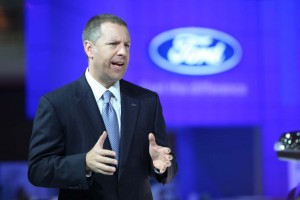Ford Motor Company plans to hire 2,200 salaried workers in the U.S. this year – the largest increase in new salaried workers in more than a decade.
The move comes a day after the market announced it would double its quarterly dividend in recognition of its improving financial condition. The maker yielded a more than 11% profit margin for the first nine months in its core North American operations.
After years of deep cuts, the auto industry has been among the most aggressive sectors of the economy when it comes to adding jobs over the last several years, Ford’s announcement coming a day after both Honda and General Motors announced significant plans to recruit more blue and white-collar workers of their own.
Joe Hinrichs, Ford president of the Americas said the new white-collar employees are being recruited to support the continued aggressive pace Ford’s new product introductions. The planned hiring drive is in addition to the more than 8,100 combined hourly and salaried jobs Ford added in the U.S. in 2012, as the company increased production capacity and expanded engineering, manufacturing and other operations to meet the growing demand for its products.
Approximately 1,000 of the positions filled in 2012 were hourly jobs brought back to Ford plants in the U.S. from other locations, including supplier operations in Japan and Mexico.
On the blue-collar side, the company now is more than halfway to the 12,000 new U.S. jobs it committed to deliver by 2015 as part of its 2011 contract with the United Auto Workers.
“Our One Ford plan is designed to create profitable growth, and our new hiring is a direct result of our plan working,” said Hinrichs, who took over as Ford’s President of the Americas last month, replacing Mark Fields who was promoted to become the maker’s new Chief Operating Officer.
“As we expand our product lineup of fuel-efficient vehicles, we need more people in critical areas – such as in a range of engineering activities, vehicle production, computer software and other IT functions – to ensure we deliver the vehicles people want and value,” he said.
Hinrichs said Ford’s U.S. hiring also will help support the company’s global product momentum. Ford is committed to serving customers across the globe with a full family of vehicles offering the best in quality, fuel efficiency, safety, smart design and value, he said.
As part of the campaign to attract new talent to the company, Ford is expanding its use of social media to reach new, technology-savvy workers, including such sites as Twitter, Facebook and LinkedIn. The company also is stepping up its recruiting efforts to reach military veterans.
New COO Fields also said last month the automaker was considering moving some jobs into the city of Detroit to attract younger employees who are interested in living and working in an urban environment. But most of the new workers will be located on Ford’s sprawling technical campus in Dearborn, Michigan.
Ford isn’t the only maker increasing its payroll. On Thursday, General Motors announced it would hire 1,000 workers at a new IT center it is establishing in the Atlanta suburb of Roswell. That is the third new site since GM announced last year plans to insource information technology work. A fourth site is still being finalized. Ultimately, Chief Technology Officer Randy Mott said the maker would have about 10,000 IT workers in the U.S., “90% GM-badged.” It currently employs just 2,200.
(For more on GM’s IT plans, Click Here.)
Honda also plans to expand, adding 50 new jobs to its factory in Marysville, Ohio later this year to handle the production of a new hybrid version of that maker’s latest-generation Accord sedan. The project will cost $23 million, Honda said, and increase the footprint at the oldest of its North American plants by 95,000 square feet.”
(Click Here for more on Honda’s Accord Hybrid announcement.)
Chrysler has also made significant additions to its workforce in recent months, adding a third shift at its prime Jeep plant in Detroit and boosting production at a number of other facilities around the country.
Nissan, meanwhile, intends to add 400 more jobs in Canton, Mississippi to handle production of the next-generation Murano crossover when it comes to the U.S. in 2014. (Click Here for more.)
Industry analysts expect the trend to continue if the U.S. automotive market continues to gain momentum. Sales increased by about 15% in 2012 to 14.5 million and GM CEO Dan Akerson this week forecast demand could rise by as much as 1 million more vehicles in 2013.


While ~3,000 new jobs is a drop in the bucket compared to the millions lost over the past 5 years, it’s a small step in the right direction. I’d much rather see new U.S. jobs and less outsourcing of everything possible to China, Mexico, Brazil, etc. When you eliminate enough U.S. jobs you end up with an economic depression and you reduce the number of consumers who can actually purchase your product.
The old adage that what goes around, comes around is exactly what happens when car makers decide to outsource to other countries to save a few pennys over U.S. production of the part.